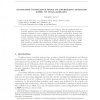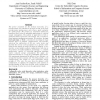110
Voted
AIPS
2008
15 years 3 months ago
2008
Many current heuristics for domain-independent planning, such as Bonet and Geffner's additive heuristic and Hoffmann and Nebel's FF heuristic, are based on delete relaxa...
AIPS
2008
15 years 3 months ago
2008
The development of informative, admissible heuristics for cost-optimal planning remains a significant challenge in domain-independent planning research. Two techniques are commonl...
68
Voted
AIPS
2007
15 years 3 months ago
2007
Scheduling the James Webb Space Telescope (JWST) requires modeling and minimizing the buildup of angular momentum of the spacecraft. Accounting for momentum management is expected...
AAAI
2008
15 years 3 months ago
2008
Heuristic search using algorithms such as A and IDA is the prevalent method for obtaining optimal sequential solutions for classical planning tasks. Theoretical analyses of these ...
97
Voted
AAAI
2007
15 years 3 months ago
2007
We present black-box techniques for learning how to interleave the execution of multiple heuristics in order to improve average-case performance. In our model, a user is given a s...
103
click to vote
CP
1995
Springer
15 years 4 months ago
1995
Springer
We present a new heuristic approach for maximal constraint satisfaction of overconstrained problems (MAX-CSP). This approach is based on a formulation of CSP as an optimization pro...
106
Voted
RTA
2010
Springer
15 years 4 months ago
2010
Springer
Decreasing diagrams technique (van Oostrom, 1994) is a technique that can be widely applied to prove confluence of rewrite systems. To directly apply the decreasing diagrams techn...
80
Voted
DATE
2004
IEEE
15 years 4 months ago
2004
IEEE
The power consumed by the memory hierarchy of a microprocessor can contribute to as much as 50% of the total microprocessor system power, and is thus a good candidate for optimiza...
CNSR
2004
IEEE
15 years 4 months ago
2004
IEEE
In this paper we discuss the kinds of ambiguities a heuristic encounters during the process of user session reconstruction. Some criteria are introduced to measure these ambiguiti...
112
Voted
AINA
2004
IEEE
15 years 4 months ago
2004
IEEE
Network services for finding a feasible or an optimal path subject to multiple constraints on performance metrics such as delay, jitter, loss probability, etc. give rise to multip...





